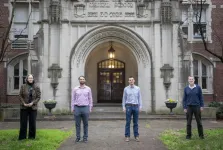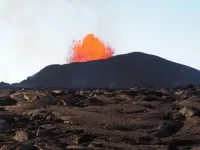(Press-News.org) In a new paper published in the Journal of Environmental Policy & Planning, the University of Maryland teamed up with local researchers to examine green infrastructure adoption and leadership in Tucson, Arizona, an interesting case study where grassroots efforts have helped to drive policy change in a growing urban area surrounded by water-constrained desert. Green infrastructure (any installation that manages water or environmental factors, such as rain gardens, stormwater basins, or urban tree cover) is slowly transitioning from a fringe activity to an important part of the way governments and municipalities are dealing with water and the local effects of a changing climate. By examining the trajectory of sustainability and the role of policy entrepreneurship in broader adoption, Tucson can provide a peek into the future of green infrastructure in the Southwest and across the country.
"This work came out of a long term collaboration in Arizona trying to understand a lot of aspects of how green infrastructure (GI) is used there," says Mitchell Pavao-Zuckerman, assistant professor in Environmental Science and Technology at UMD. "We are looking at the functionality of GI, its practical benefits, but also how governance and learning around GI changes, inhibits, or helps adoption. Looking at evolution and adoption, we can see different types of players that are key, like policy entrepreneurs who are early adopters or innovators in either practice or policy and how they help diffuse knowledge around the city. Learning these lessons, we gain a lot of insight into how policy is changing, and how other areas could adapt going forward."
Funded by the National Science Foundation's (NSF) Coupled Human and Natural Systems program, Pavao-Zuckerman collaborated with the University of Arizona, the Udall Center for Public Policy in Tucson, and the University of Virginia to examine these GI trends. The researchers took a mixed methods approach to the work, examining policy, documentation, and newspaper reports to create a timeline of GI developments in the history of the city. The timeline was then used as a starting point when interviewing stakeholders and GI players in Tucson, providing a richer context and backdrop to the interview data.
"The timeline and our approach to gathering this information is innovative; it puts a method behind anecdotal stories," explains Pavao-Zuckerman. "Studying this kind of process in an urban setting around GI is a new thing, so that is one of the unique pieces of this paper. In lots of places, you have this knowledge and history of how things have come about, but using the timeline and interviews to document how things have changed, and putting it within theories of adaptation and governance - these are new frontiers for working with GI and urban environments."
As Pavao-Zuckerman describes it, Tucson provides a compelling look at how GI emerges in places that don't necessarily have water quality mandates, which are prominent in Maryland and the area surrounding the Chesapeake Bay. In Tucson and much of the Southwest, water sustainability and conservation is often the driver.
"In Maryland with the Bay, a lot of GI is implemented as a way to meet water quality standards and meet pollution reduction targets," says Pavao-Zuckerman. "But in this case, there aren't water quality mandates, and the focus is really on harvested water. A lot of water consumption in the Southwest goes to domestic irrigation for lawns and gardens, which can sometimes be up to 50% of potable water usage, so the demand is huge. You also see integration with urban tree canopy and stormwater basins that can help mitigate heat islands and buffer for future climate change when things get even hotter out there. So you see the same types of things there as in the Bay area, like curb cuts to redirect stormwater and urban tree cover, but it is coming from a different place. So it is interesting to see how you get to the same place from a different start point."
One thing that Pavao-Zuckerman and the team found in Tucson that the rest of the country can learn from is an overall culture of what is known as water ethics. Similar to the concept of One Health (the intersection and interconnectedness of animal, human, and environmental health), Tucson water municipalities call it One Water.
"Part of what we see going forward is a more holistic way of thinking about water," says Pavao-Zuckerman. "Stormwater is usually thought of as a waste stream that we want to get rid of as quickly as possible, but people are starting to see it as a resource and not a waste. The water municipality there calls it One Water, thinking about the integration of the whole water system. Instead of thinking of stormwater and drinking water as two separate things, we think about water collectively, and that gives you a different perspective for management. That mindset will hopefully also start to happen in other places."
Other key findings from the paper include the need to think about GI across all scales, from individual and neighborhood adoption to the city level. Additionally, there is a need for more equitable dispersion of GI to ensure environmental and social justice.
"A lot of this practice is done effectively voluntarily," explains Pavao-Zuckerman. "Neighborhoods and the city will promote it, but the city isn't necessarily going out and implementing most of these structures - that is up to the home or property owner. Because implementation has started from policy entrepreneurs and individuals in Tucson, it didn't happen randomly and also didn't happen necessarily in communities where it is most needed. Most cities are like this, with more affluent communities having more implementation, and places that have less money or more people of color tend to have less implementation, so they are bearing the brunt of the environmental harms that they are trying to solve. So that needs to be part of the trajectory going forward, thinking about how to shift practice to reflect that and encourage cooperation at all levels and scales to be more equitable."
Overall, this paper provides a landscape of GI implementation and gives researchers, policy makers, and advocates alike a chance to understand where things are coming from so they can think more strategically about where things are headed.
"It lets us do backcasting and forwardcasting," emphasizes Pavao-Zuckerman. "We can see where things came from and new threads that are starting to emerge. GI is important because it adds different aspects of resilience to an environment. It helps to buffer environmental extremes, and it adds more flexibility throughout the landscape to withstand and respond to extreme events. We think of climate change as this thing that is going to be hotter, wetter, or drier, but it is the extreme ends of weather events that really hit cities and people hard, and GI is something that we think is going to really help. We are paying particular attention to the role of people and organizations in driving GI change in this work to understand it as a way for how people can shape urban transformations to make a more sustainable and resilient community."
INFORMATION:
This paper is entitled "Agency and governance in green infrastructure policy adoption and change" and is published in the Journal of Environmental Policy & Planning, DOI: 10.1080/1523908X.2021.1910018.
This work is funded by the National Science Foundation, Grant Number Award #1518376, Linking Ecosystem Services and Governance of Water Resources in Urbanized Landscapes.
Tumors consume glucose at high rates, but a team of Vanderbilt researchers has discovered that cancer cells themselves are not the culprit, upending models of cancer metabolism that have been developed and refined over the last 100 years.
Instead, non-cancer cells in a tumor -- primarily immune cells called macrophages -- have the highest glucose uptake, the group reported April 7 in the journal Nature. The findings that different cells in the tumor microenvironment use distinct nutrients according to their own metabolic programs could be exploited to develop new therapies and imaging strategies, ...
Washington, DC-- The 2018 eruption of Kīlauea Volcano in Hawai'i provided scientists with an unprecedented opportunity to identify new factors that could help forecast the hazard potential of future eruptions.
The properties of the magma inside a volcano affect how an eruption will play out. In particular, the viscosity of this molten rock is a major factor in influencing how hazardous an eruption could be for nearby communities.
Very viscous magmas are linked with more powerful explosions because they can block gas from escaping through vents, allowing pressure ...
Children experiencing cognitive problems such as low attention, poor memory or lack of inhibition may later suffer mental health issues as teenagers and young adults, a new study reveals.
Targeting specific markers in childhood for early treatment may help to minimise the risk of children developing certain psychopathological problems in adolescence and adult life, such as borderline personality disorder, depression and psychosis.
Cognitive deficits are core features of mental disorders and important in predicting long-term prognosis - the researchers' work indicates that individual patterns of such deficits predate ...
What The Study Did: This case series examines whether maternal SARS-CoV-2 is associated with outcomes in the eyes of their newborns.
Authors: Olívia Pereira Kiappe, M.D., M.Sc., of Universidade Federal de São Paulo in Brazil, is the corresponding author.
To access the embargoed study: Visit our For The Media website at this link https://media.jamanetwork.com/
(doi:10.1001/jamaophthalmol.2021.1088)
Editor's Note: Please see the article for additional information, including other authors, author contributions and affiliations, conflict of interest and financial disclosures, ...
What The Study Did: This observational study identifies and quantifies the association of race/ethnicity, sex and income, as well as state-specific lockdown measures, with six well-being dimensions in the United States.
Authors: Leigh C. Hamlet, B.S., of the University of Washington in Seattle, is the corresponding author.
To access the embargoed study: Visit our For The Media website at this link https://media.jamanetwork.com/
(doi:10.1001/jamanetworkopen.2021.7373)
Editor's Note: The article includes funding/support disclosures. Please see the article for additional information, including other authors, author contributions and affiliations, conflict of interest and financial disclosures, ...
A new estimation of the strength of the magnetic field around the muon--a sub-atomic particle similar to, but heavier than, an electron--closes the gap between theory and experimental measurements, bringing it in line with the standard model that has guided particle physics for decades.
A paper describing the research by an international team of scientists appears April 8, 2021 in the journal Nature.
Twenty years ago, in an experiment at Brookhaven National Laboratory, physicists detected what seemed to be a discrepancy between measurements of the muon's "magnetic ...
What The Study Did: Researchers report on the observation of a newly associated mucocutaneous eruption in a pediatric patient with confirmed SARS-CoV-2 infection
Authors: Zachary E. Holcomb, M.D., of Boston Children's Hospital, is the corresponding author.
To access the embargoed study: Visit our For The Media website at this link https://media.jamanetwork.com/
(doi:10.1001/jamadermatol.2021.0385)
Editor's Note: Please see the article for additional information, including other authors, author contributions and affiliations, conflict of interest and financial disclosures, and funding and support.
INFORMATION:
Media advisory: The full study is linked to this news release.
Embed this link to provide your readers ...
What The Study Did: In this observational study of 3.4 million live births in 2018, criminalizing immigrant policies were associated with higher rates of preterm birth for Black women born outside the U.S., while inclusive immigrant policies were associated with lower preterm birth for all women born outside the U.S.,particularly White women born outside the U.S.
Authors: May Sudhinaraset, Ph.D., of the Jonathan and Karin Fielding School of Public Health at the University of California, Los Angeles, is the corresponding author.
To access the ...
What The Study Did: Researchers projected to the year 2040 what will become the most common and deadly cancers in the United States.
Authors: Lola Rahib, Ph.D., of Cancer Commons in Mountain View, California, is the corresponding author.
To access the embargoed study: Visit our For The Media website at this link https://media.jamanetwork.com/
(doi:10.1001/jamanetworkopen.2021.4708)
Editor's Note: The article includes funding/support disclosures. Please see the article for additional information, including other authors, author contributions and affiliations, conflict of interest and financial disclosures, and ...
What The Study Did: Questionnaire responses were compared to examine whether transgender children and teens experience significantly higher levels of anxiety and depression than their cisgender peers.
Authors: Dominic J. Gibson, Ph.D., of the University of Washington in Seattle, is the corresponding author.
To access the embargoed study: Visit our For The Media website at this link https://media.jamanetwork.com/
(doi:10.1001/jamanetworkopen.2021.4739)
Editor's Note: The article includes conflicts of interest and funding/support disclosures. Please see the article for additional information, ...


